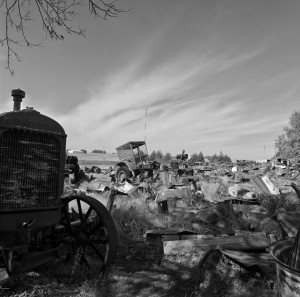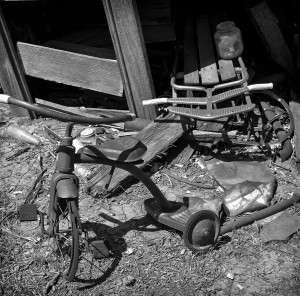page 17 of 20
Salvage and Junk
 What ceases to be salvaged consolidates into junk. Left to their devices, all salvage yards would become junk yards, and fairly quickly, given their common ingredients. Some yards are junky from the start, others drift in that direction. Visible in salvage is the object of its detention. Items of value are rotated forward. Turnover is the very point. Salvaged things are sorted by composition or design: they’re ferrous or non-ferrous, cast or steel, pinion gear or radiator. A junk yard, on the other hand, is a thousand defections from order. Junk scatters or is tossed in incoherent piles. It comingles, forgets its intended purpose, shuns a teleology. We all know junk when we see it, unless we happen to own it. It just sits there in the weeds.
What ceases to be salvaged consolidates into junk. Left to their devices, all salvage yards would become junk yards, and fairly quickly, given their common ingredients. Some yards are junky from the start, others drift in that direction. Visible in salvage is the object of its detention. Items of value are rotated forward. Turnover is the very point. Salvaged things are sorted by composition or design: they’re ferrous or non-ferrous, cast or steel, pinion gear or radiator. A junk yard, on the other hand, is a thousand defections from order. Junk scatters or is tossed in incoherent piles. It comingles, forgets its intended purpose, shuns a teleology. We all know junk when we see it, unless we happen to own it. It just sits there in the weeds.
Everything parked seems frozen, yet it keeps moving, keeps creeping toward oblivion. An elm grows through an engine compartment; lifts it, wrests it, rends it. There’s no pressure like growth pressure. Wood and rubber and canvas rot. Glass goes to smithereens. Bolts in desiccated wooden wagons shrivel along their threads, narrow to rusty points and drop their nuts. These nuts are sterile, so that line of wagon dies out. Axle grease, pierced by the grit in a thousand winds, comes to look like pumpernickel. Lichens, in their orange or green or putty filigrees, colonize slabs of sheet metal. Old iron bleeds electrons into the soil, on its way home. The ground becomes the reaper. Nature wants it all back. It insists!
Asking Around
 For years I’ve pulled into farmsteads to ask permission to shoot. I always ask, not because I’m virtuous, but because nervousness screws the pooch, ruins intuition. I’d be too busy looking over my shoulder to really see. And besides, I remember how we felt when coyote hunters cut across our fields with greyhounds and a finishing mutt.
For years I’ve pulled into farmsteads to ask permission to shoot. I always ask, not because I’m virtuous, but because nervousness screws the pooch, ruins intuition. I’d be too busy looking over my shoulder to really see. And besides, I remember how we felt when coyote hunters cut across our fields with greyhounds and a finishing mutt.
I’m usually after something visible from the road: an old machine, a gully full of brittle wire, laundry on a line. For several years, I specialized in twisted buildings on the verge of collapse, which are best shot low and wide. It’s the balloon framing that allows them to arch and pivot so exquisitely before they drop. The houses I’ve built are platform framed, so it occurs to me now that I have no idea how they’ll fall; inwardly, I’d imagine, with veneers peeling like pages.
I pursued this subject out of gratitude, because my first good photograph was of a two-story farmhouse about to slip backward. It has a shipwreck-in-a-cornfield feel. The house appears to hang by threads from the moon off its peak. The moon, of course, is anchored by some distant tide. Shortly after I shot this house, it collapsed, granting me an exclusive, which I mistook for an omen. I’m afraid most of the photos from this period are clichés, but they were all good practice, and I always enjoyed the meandering, the poking around. A camera lets you show up anywhere looking a little less like a thief.
 I’m shy, so I dread asking permission, even after years of good luck, even when I know some of these conversations will be heartening. In my experience, 15 percent or so will simply decline and close the door. I don’t mind these folks. I don’t particularly enjoy the response, but it’s quick, like ripping off a Band-Aide. I have the worst luck with those who hunker in their bunkers, certain I’m the killer from the evening news. They mumble past doors ajar and copy down my license plate. I have my best luck with young farmers, who like to speak through screen doors in their hat-hair and stocking feet. “Sure,” they say. “Go ahead. Don’t hurt yourself. Remember to close the gate.”
I’m shy, so I dread asking permission, even after years of good luck, even when I know some of these conversations will be heartening. In my experience, 15 percent or so will simply decline and close the door. I don’t mind these folks. I don’t particularly enjoy the response, but it’s quick, like ripping off a Band-Aide. I have the worst luck with those who hunker in their bunkers, certain I’m the killer from the evening news. They mumble past doors ajar and copy down my license plate. I have my best luck with young farmers, who like to speak through screen doors in their hat-hair and stocking feet. “Sure,” they say. “Go ahead. Don’t hurt yourself. Remember to close the gate.”
